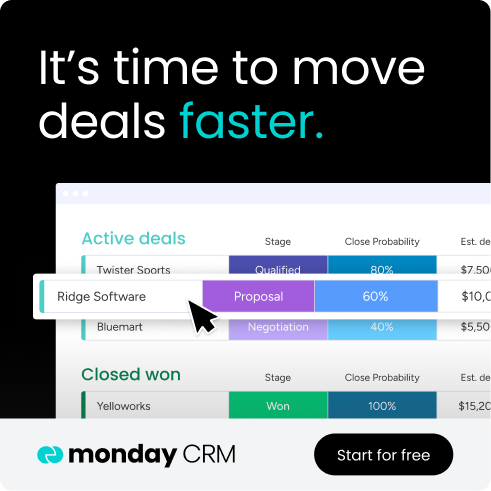Successful business owners and marketing managers share a common understanding: You can’t reach the right customers if you don’t know who they are. That’s why they build customer profiles. But without the right tools, this can be a challenge.
In this guide, we’ll discuss the benefits of creating customer profiles and using templates, highlight some examples, and show you how the right software — like monday CRM, powered by AI and automation — can help you build customer profiles based on real data.
Get startedWhat is a customer profile?
A customer profile is a centralized record of everything you know about a customer or customer segment — combining both operational data (like transactions, purchase history, and CRM interactions) and experiential data (such as satisfaction scores, feedback, or engagement behavior). It paints a clear, data-backed picture of who your customers are and how they interact with your brand, helping teams across marketing, sales, and product make better decisions.
Businesses often use a customer profile template to capture this information consistently across teams and systems. Over time, these templates reveal patterns among your most valuable customers — patterns you can use to shape an ideal customer profile (ICP), or the type of customer you want to attract more of.
In other words, customer profiles describe your existing customers, and an ideal customer profile builds on that knowledge to define your best-fit prospects.
B2B vs. B2C customer profiles
Both B2B and B2C customer profiles serve the same goal — understanding your audience — but the data they rely on differs.
- B2B profiles emphasize firmographics like industry, company size, and decision-making structure.
- B2C profiles focus more on demographics and psychographics such as lifestyle, motivations, and buying behaviors.
This table highlights these differences in more detail:
| B2B customer profile | B2C customer profile | |
|---|---|---|
| Organization or occupation | Industry, company size, revenue, structure, and technology stack | Occupation or field of work when relevant (e.g., healthcare, construction, education) |
| Decision-making | Multiple stakeholders, longer sales cycles, defined approval processes | Individual or household decisions, shorter buying cycles |
| Demographics | Job roles, departments, seniority levels, and geographic markets | Age, gender, income, education, location, and family status |
| Behavioral and engagement data | Website activity, product usage, deal stage, renewal frequency, and content engagement | Shopping habits, brand interactions, browsing and purchase behavior |
| Goals and motivations | Business growth, efficiency, cost reduction, or compliance | Lifestyle improvements, convenience, status, or problem-solving |
| Pain points and challenges | Operational inefficiencies, budget constraints, ROI expectations, scalability issues | Personal frustrations, unmet needs, emotional triggers, or quality concerns |
Customer profile vs. customer persona
Customer profiles and customer personas are related but distinct.
- A customer profile focuses on objective, data-driven information about a customer segment — demographics, behaviors, firmographics, and key interactions.
- A customer persona (or buyer persona) is a semi-fictional representation of an individual within that segment, created to humanize your audience for marketing and sales purposes.
For example, a customer profile might define “SaaS companies with 50–200 employees and $5–10M in annual revenue,” while a buyer persona would describe “Ava, a marketing director who needs visual dashboards to track campaign ROI.”
Key components to include in a customer profile
Businesses often maintain more than one customer profile, especially if they offer multiple products or serving different markets. Each profile should consolidate verified data from CRM systems, analytics tools, and customer feedback channels.
Regardless of how many profiles you build, make sure each includes most of the following key components — adjusted for B2B or B2C needs:
-
Demographics: Concrete attributes such as age, gender, location, income level, education, and household or professional status
-
Psychographics: Documented values, interests, and lifestyle indicators gathered from surveys, engagement data, or feedback that reveal why customers choose your brand
-
Firmographics (B2B): Industry sector, company size, revenue range, organizational structure, technology stack, and growth stage — all drawn from CRM or enrichment data
-
Behaviors: Observable actions such as purchase frequency, feature usage, preferred channels, support interactions, and touchpoints along the customer journey
-
Pain points: Common challenges or service issues surfaced through reviews, support tickets, or sales conversations
-
Goals and success indicators: What customers are trying to achieve with your product or service, measured through adoption metrics or outcome surveys
-
Preferences: Known communication methods, content formats, or pricing options that drive engagement and retention
Once you’ve identified the data that matters most, the next step is choosing a format that helps you capture and share it effectively.
Choosing the right template format
Whether you’re building your first profile or refining an existing one, the format you choose can make collaboration easier. Many teams start with editable templates in Excel, Google Docs, Word, or PowerPoint because they’re easy to customize and share.
Unfortunately, this often leads to the dreaded “multiple versions” problem — different team members updating their own copies until no one’s sure which is the real final version. Once your data grows, those scattered files can slow down alignment and create inconsistencies.
That’s where a CRM like monday CRM comes in. It lets teams centralize every customer profile, automate updates, and ensure everyone’s always working from the same accurate, AI-enhanced dataset.
Why every business needs a customer profile template
Using a customer profile template enables businesses to efficiently gather, organize, and analyze customer data, leading to a deeper understanding of their target audience. This structured approach delivers measurable benefits across marketing, sales, and product development. Here’s how:
Ensures comprehensive and consistent data collection
A well-designed template with predefined fields guides you to capture all relevant information from CRM systems, forms, and analytics tools about your existing and potential customers.
This consistency enables accurate comparisons and analysis across different customer segments, leading to better-informed decisions.
Ensures targeted and personalized marketing
Customer profiles provide insights into demographics, behaviors, preferences, and needs, allowing businesses to tailor marketing campaigns, messaging, and offers to specific customer segments. This can lead to higher engagement, conversion rates, and marketing ROI.
Plus, when templates are connected to your CRM, updates flow automatically into marketing segments for real-time targeting.
Guides product development and improves customer satisfaction
Analyzing real customer pain points and usage data helps teams develop products and services that better meet customer needs and increase customer satisfaction and loyalty.
Optimizes customer acquisition and retention
With a clear view of audience characteristics and behaviors, teams can refine acquisition strategies and strengthen retention through more personalized experiences.
Improves resource allocation and efficiency
Profile data highlights the most valuable customer segments, enabling businesses to focus their resources and marketing spend on the most promising prospects, improving efficiency and profitability.
Supports alignment and scalable growth
When teams work from a shared template, everyone — from marketing to service — has access to the same customer insights, improving cross-department alignment.
Profile insights reveal market penetration levels and untapped opportunities, supporting data-driven expansion and account-based marketing in B2B contexts.
5 steps to build a customer profile template
Before you start building your customer profile template, you need to gather the right data. Jumping straight into design without real customer insights won’t give your business the structure it needs. By following the steps outlined here, you can create a customized customer profile template you can easily replicate and refine over time.
1. Analyze your current and top customers
To begin, start by combing through your existing customer base to gather data points. The first thing you’ll want to do is determine your most loyal customers by looking at metrics like a high net promoter score or customers who have been loyal to your company over a long period of time. These power users highlight the traits and behaviors that define your most valuable customer segments.
2. Determine similarities and common pain points
Once you’ve found your most engaged customers, start digging deeper into their profiles. Look for similarities across the board, such as:
- Do they have similar pain points?
- Are they located in the same region?
- Are they in a similar industry?
- How did they find your company?
- In what way do they benefit from your product or service?
By asking questions that look at similarities in firmographics, behavior, and preferences, you can start to identify shared traits you can include in your customer profile template. These insights can later be pulled into your CRM to help refine segmentation and targeting.
3. Gather customer feedback
Next, you should actually engage with those loyal customers to gather feedback on your business. Even when looking at data, you may be missing powerful insights, such as how a customer truly feels about your product or interacting with your business.
Ongoing feedback cycles, including surveys, online reviews, and interviews, can be used to determine additional similarities.
4. Use your findings to build a template and refine
When you have all your data on your customers and power users, you can start building out your customer profile template. Look at examples online or from other businesses to get an idea of where to start, and then, using the data you collected, determine the most important factors to look at in your customer profile.
Over time, you can refine this template as your data set expands or customer behavior changes.
5. Choose the right software to manage your customer profiles
A customer relationship management (CRM) system can help you gather ongoing customer data and automatically update profiles over time. With a solution like monday CRM, teams can create and personalize multiple customer profile templates, track every customer interaction, and use AI-powered insights to identify trends across segments.
Get startedCustomer profile template examples to get you started
You can find free customer profile templates in Excel, Google Docs, Word, and PowerPoint (PPT) formats to get started quickly and customize them to your brand. Then, import those templates into your CRM to keep every version synced and up to date.
If you’re not sure where or how to get started, it’s helpful to look at some examples of existing templates to get some inspiration. The examples here cover a few different customer profiles and can be applied to different types of businesses.
Simple customer profile template
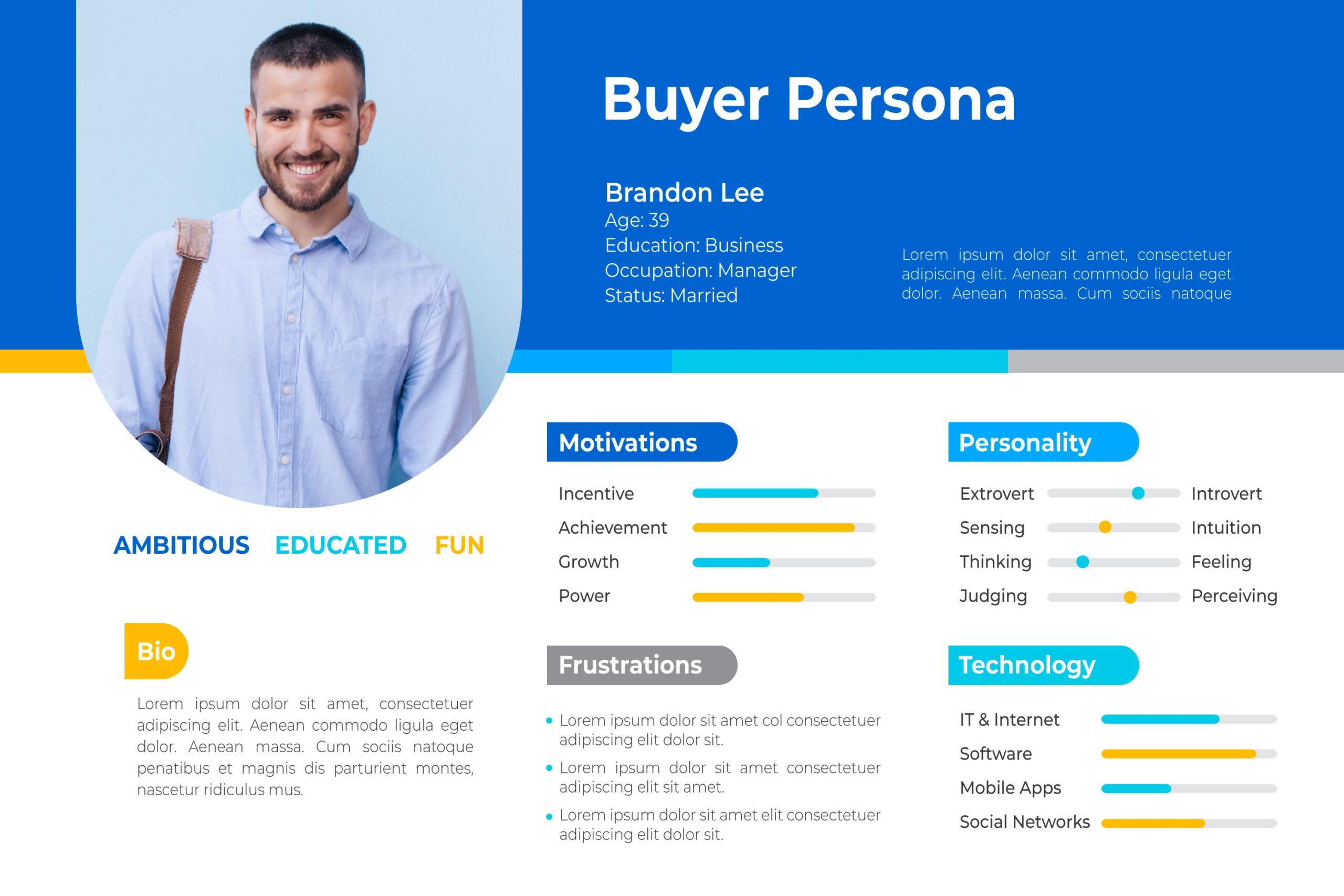
(Source)
Though the general rule with customer profiles is “the more information, the better,” you certainly don’t have to create multi-page documents describing every habit and characteristic your most valuable customers might exhibit.
This template is a great example of how a simple B2C customer profile can still offer actionable insights. As you’ll notice, it includes the most crucial customer information, such as demographics, psychographics, behaviors, goals, and more.
Free online templates
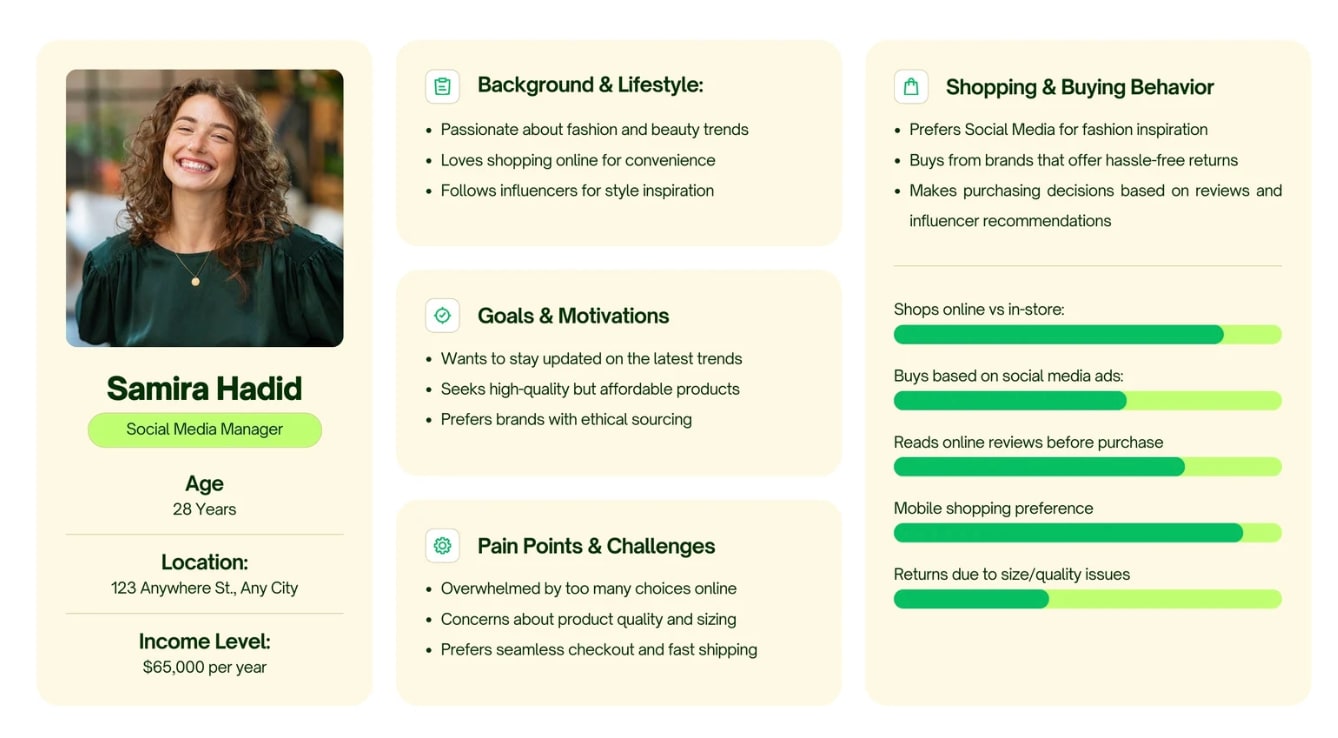
(Source)
There are a number of places online you can find free customer profile templates. For example, Canva has many free customer profile templates that can be customized for your brand and shared with your team. You can also collaborate inside the app to get feedback on the profile.
Visual customer profile template

(Source)
You can also download free PowerPoint-style customer profile templates if you want to create a slideshow or deck to present to stakeholders, employees, or coworkers. This format is highly visual and often features infographics or stock photography that embodies the customer profile you’ve developed.
Custom B2B customer profile template example
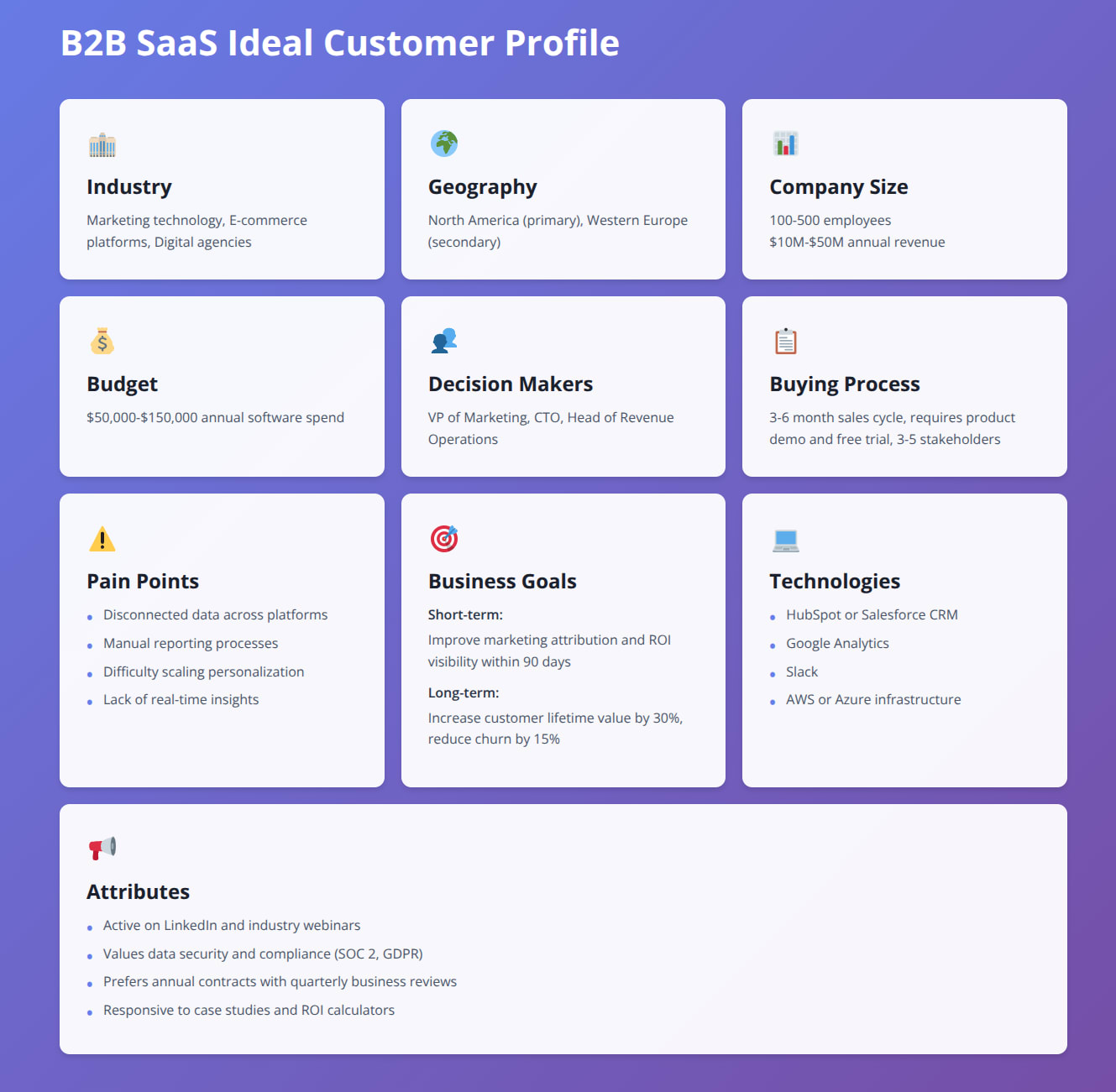
You can create your own customer profile from scratch in something as simple as a Word or Google Doc. But if you want to make it more visual, consider using AI tools that can automatically format your data into a polished, presentation-ready layout.
For example, you can generate a visual B2B customer profile for a SaaS company using real CRM data, then export it as a PDF or slide deck to share with your team.
Elevating your customer profiles with monday CRM
Customer relationship management systems, like monday CRM, enable you to analyze your existing customer data more effectively, identify patterns, and derive actionable insights. CRM software can also be an asset when it comes to creating different customer profiles, thanks to the data it collects from conversations and behaviors over time.
With monday CRM, sales teams can access high-level insights on customer behavior, including engagement levels, demographics, and preferences, that can be used to craft reliable customer profiles. Not only that, but the platform’s built-in AI can also highlight important customer data you may have overlooked, giving you a more complete picture to base your profiles on.
Here’s a look at some of the main monday CRM features that will help you improve your customer profiles.
Advanced customer data and analytics
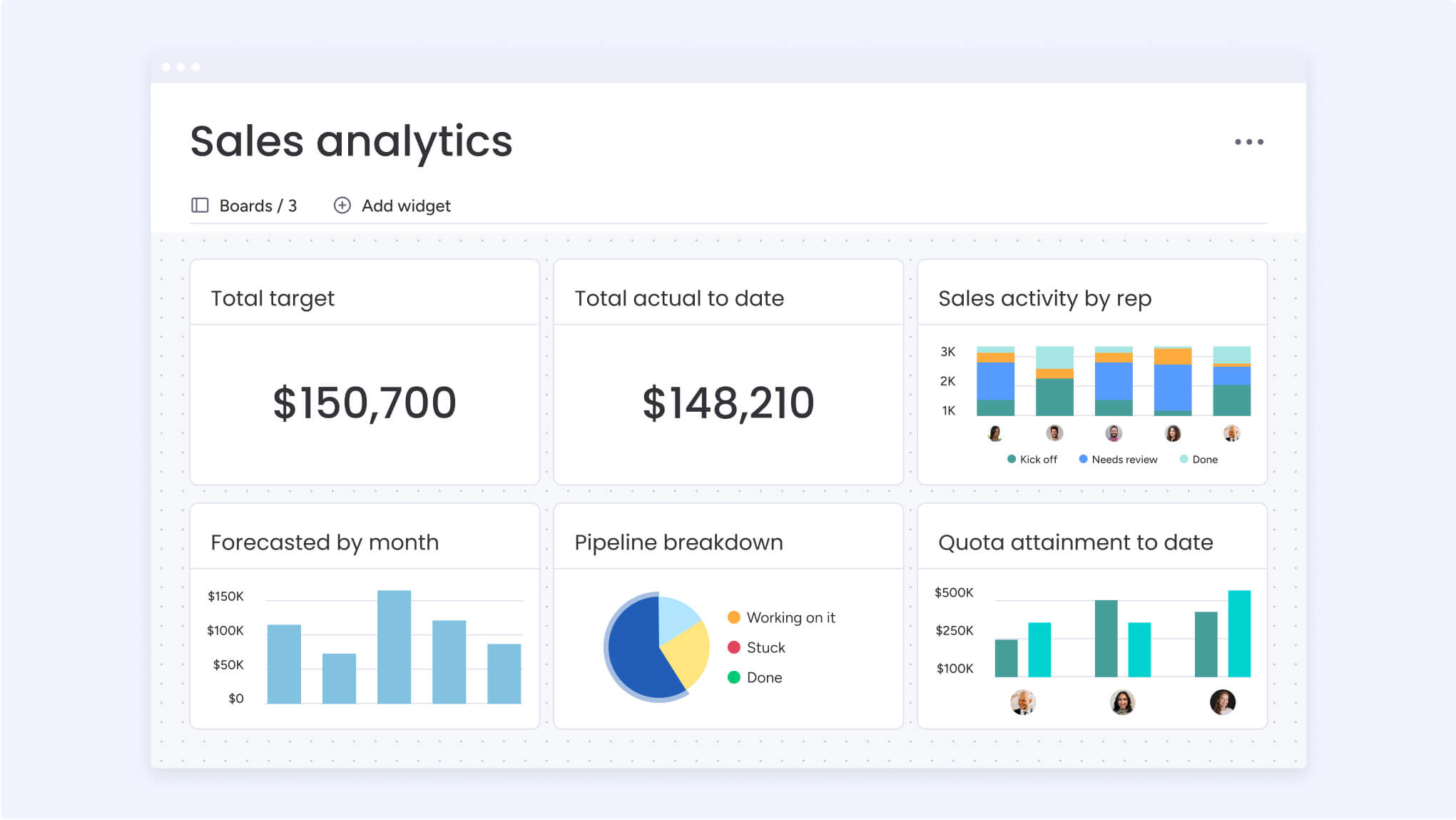
Sales and marketing teams can gather data thanks to monday CRM’s AI-powered dashboard analytics and reports. These insights can be used to create detailed customer profiles that are based on general customer behavior. Additionally, teams can monitor AI reports and dashboards to see when there’s a change in customer behavior so that profiles are regularly updated.
Custom forms to survey top customers
Teams can use monday CRM to send custom forms to the most loyal customers to gather feedback and generate reports with the data. In turn, teams can implement this feedback into customer profiles and gather analytics directly from form responses to identify patterns and similarities in customer behavior.
Automation and AI to streamline customer profiles
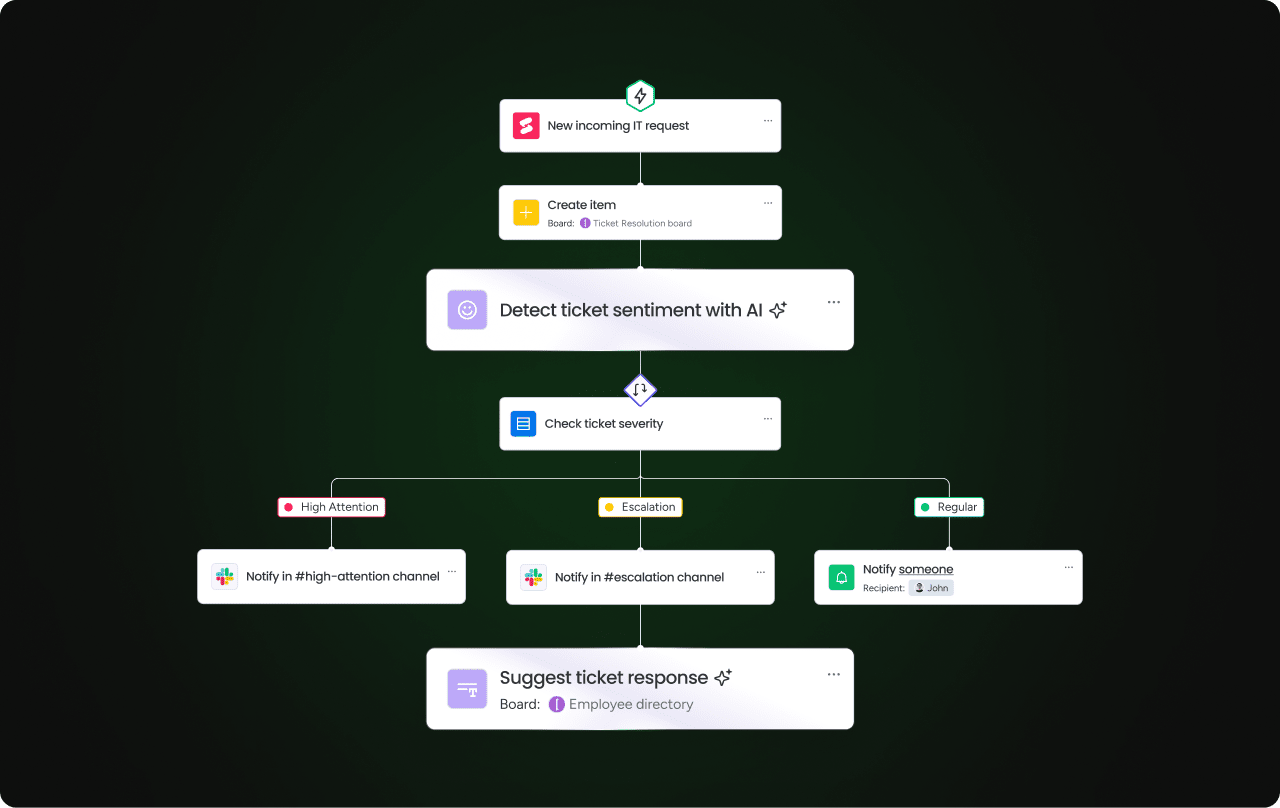
Data is everything when it comes to creating a customer profile, and AI and automation help teams gather reliable data. For example, in monday CRM, users can create AI-driven automations to engage and nurture new leads, allowing teams to gather data on user behavior throughout the pipeline that can be used to create customer profiles.
Personalized messaging that aligns with profiles
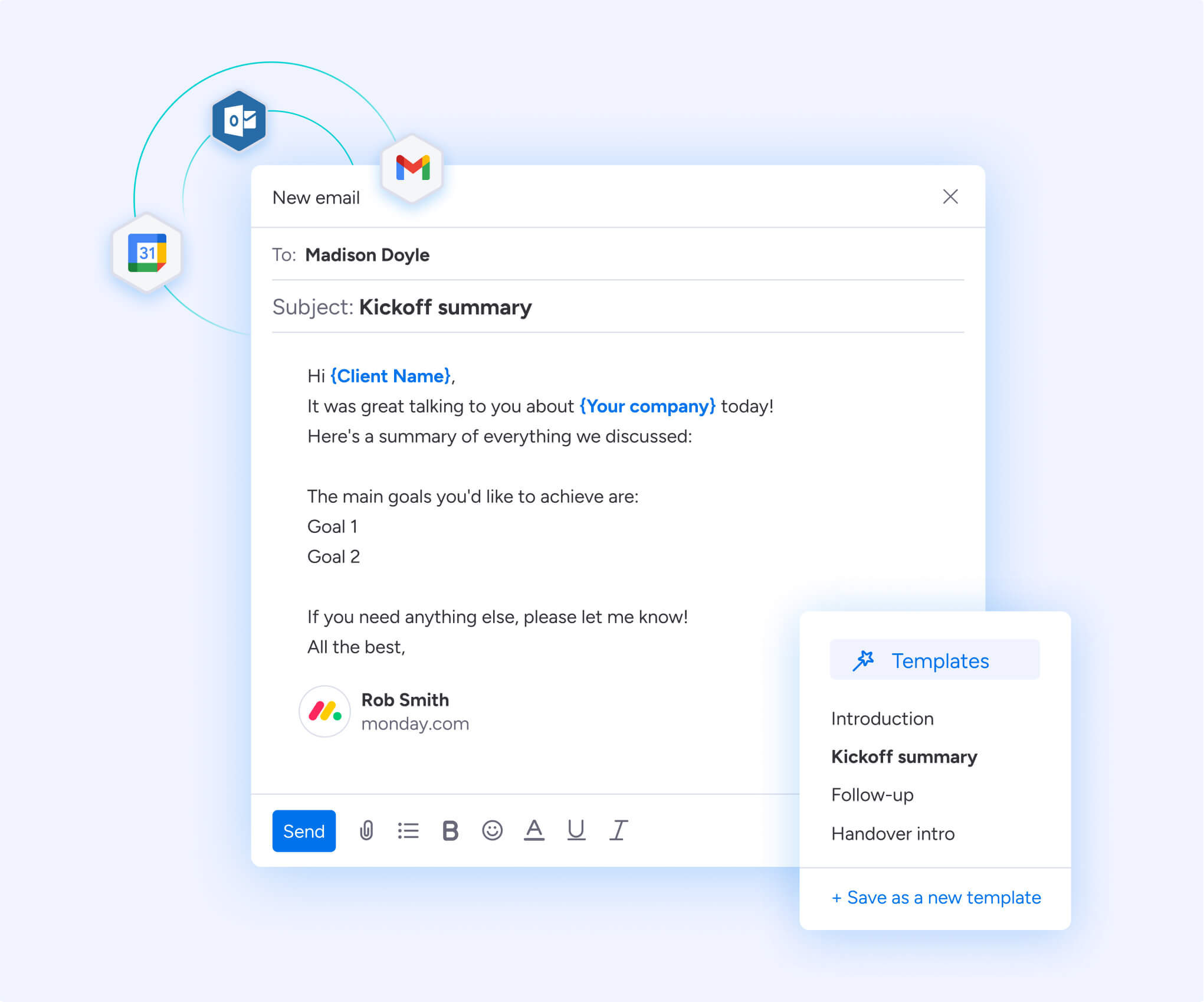
Once your customer profiles are finalized, you can create custom segments in monday CRM that align with each profile. Then, using built-in automations and AI generation, users can create personalized content and messaging that aligns with every profile to boost engagement levels and customer satisfaction.
For marketing teams, monday campaigns takes these insights even further. As part of monday CRM, monday campaigns uses AI to segment audiences, personalize messaging, and launch campaigns based on your customer data. This seamless link between CRM and campaign tools helps teams move from insights to impact — turning customer profiles into revenue-driving actions.
The dos and don’ts of building a customer profile: Mistakes to avoid
Creating customer profiles may seem straightforward if you follow all the steps we covered and use the right software. However, there are some common mistakes that can creep into the process and throw off the accuracy of your customer profile. Let’s cover some things you should do and mistakes to avoid when creating customer profiles:
1. Create multiple profiles for different customer segments
DO build separate profiles for distinct audiences or product lines
DON’T cram all your customer data into one profile just to make it fit.
Each profile should represent a clear segment with shared traits, not a mix of unrelated customers. Larger B2B or multi-product companies may need several profiles to stay accurate. With smart CRM software, you can easily clone and adapt templates for each segment while keeping all data connected in one workspace.
2. Keep your profiles fresh and up-to-date
DO schedule regular reviews to update your profiles with new data.
DON’T rely on outdated information or assumptions about your customers.
Customer behaviors evolve, and stale profiles can lead to off-target campaigns or missed opportunities. Using a CRM like monday CRM, you can track interactions automatically, monitor behavioral changes, and even set reminders to refresh key details on a recurring basis.
3. Base profiles on research, not assumptions
DO use surveys, analytics, and CRM reports to collect real insights.
DON’T make assumptions based on gut feelings or limited anecdotal knowledge.
Relying only on team intuition can skew your understanding of who your best customers really are. Instead, validate assumptions with hard data — combining interviews, market research, and CRM analytics to uncover the facts that drive better decisions.
Start building actionable, data-informed customer profiles
Creating customer profiles can be straightforward as long as you have the right tools. With monday CRM, you get a single repository with all your customer data, where you can collaborate and build customer profile templates visually while relying on AI to gather all the data you need to get a deeper understanding of your customers.
Get startedFAQs
Why is customer profiling an essential activity for marketing and sales teams?
Customer profiling is essential for marketing and sales teams since it helps them target the right prospects, personalize messaging, and allocate resources efficiently. By understanding customer demographics, behaviors, pain points, and goals, teams can create relevant campaigns, improve conversion rates, shorten sales cycles, and build stronger customer relationships that drive revenue growth and long-term loyalty.
What are the best tools for customer profiling and analysis?
The best customer profiling tools include CRM platforms like monday CRM, which centralize customer data and track interactions. Analytics tools like Google Analytics can reveal behavioral patterns, while survey platforms like Typeform gather direct feedback. Teams can also use data enrichment tools like Apollo.io to gather more firmographic information to build comprehensive customer profiles.
How often should a business update its ideal customer profile?
There’s no one-size-fits-all timeline for updating your ICP since it depends on how quickly your business grows and your team’s needs. It’s good practice to review your ideal customer profile quarterly and update it annually or when there are significant market changes. Major triggers for updates include launching new products, entering new markets, shifts in customer behavior, competitive landscape changes, or when conversion rates decline.
What questions should I include in a customer profile questionnaire template?
Your customer profile questionnaire for your clients should include questions about demographics (age, location, role), company details (size, industry, revenue), challenges and pain points, goals and objectives, current solutions being used, budget and decision-making process, preferred communication channels, and buying triggers. For B2B, add questions about technology stack, stakeholders involved, and timeline for implementation to create comprehensive profiles.
Where can I find a free customer profile template?
You can download free customer profile templates from sources like Canva, Google Docs, or PowerPoint. monday.com also offers a customizable customer profile template inside monday CRM that lets you import data, collaborate across teams, and update profiles automatically.
What’s the difference between a customer profile and a buyer persona?
A customer profile uses real data to describe your existing customers or audience segments. A buyer persona is a semi-fictional representation of an individual within that audience, used to guide messaging and creative decisions.
 Get started
Get started



